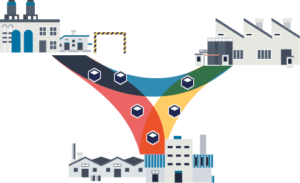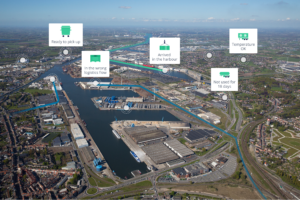Supply chain and logistics managers are always looking for ways to make their operations more efficient and effective. One way to do this is by using geolocation technology. Geolocation can help companies track the location of their assets and inventory and navigate through complex transportation networks.
With the power of IoT and geolocation, companies can now track the movement of their non-powered assets using a simple combination of battery-powered trackers and a cloud-based platform.
Therefore, with IoT technology comes the opportunity for optimization because, with complete visibility of your assets, you will always be able to ensure they are in the right place at the right time.
This article will introduce you to geolocation, how it will benefit your supply chain and logistical operations, and how Sensolus leverages geolocation technologies for the best results.
In addition, we will also summarize different types of geolocation technologies available today (along with their advantages and disadvantages, of course).
Keep reading if you’re interested in learning more about this valuable supply chain tool!
What is Geolocation?
Geolocation is a technology feature that can pinpoint the geographic location of almost anything! From a sweeping swath of land to a needle in a haystack.
By using a connected device, you can locate an important asset: be it a container, a trailer, a pallet, or really anything you want to keep in sight. Often the device is a mobile phone or an internet-connected device (Internet of Things).
The Benefits of Geolocation for Supply Chain Management
Geolocation services have a lot to offer when it comes to supply chain management and logistics:
- Companies can track their inventory, optimize delivery routes, and even predict customer demand.
- Warehouse operations will become more efficient with the use of data.
- Logistics and supply chain managers can understand how their inventory is moving throughout the supply chain and can make changes that will save time and money.
- Logistics and supply chain managers can easily pinpoint problems in the supply chain and identify potential areas for improvement.
In today’s competitive marketplace, any advantage you can gain through geolocation will help optimize your supply chain and improve your bottom line.
Geolocation is not only amazing technology – it’s good business.
Different Types of Geolocation
There are a number of technologies that will help you define the geographic location of assets. As a result, you can rely on either one geolocation technology to track your assets or combine multiple ones, Sensolus knows the right recipe (at the end of this article you will understand this approach).
This article summarizes four different geolocation technologies:
- GPS
- Bluetooth
- WiFi
- Network-based geolocation
In the next section, we will introduce these geolocation technologies and compare their advantages and disadvantages.
GPS (Global Positioning System)
Global Positioning System, GPS in short, is a satellite-based radio navigation system, with around thirty satellites orbiting the Earth.
This global satellite system sends geolocation and time stamps to a GPS receiver anywhere on or near our planet – but only if there are no obstacles and at least three GPS satellites available.
A BIG plus of GPS is its accuracy. You can precisely track your assets with GPS – as it can locate an asset by up to five meters.
The downside is that this geolocation technology requires quite some power because it communicates with several satellites around the Earth. Other disadvantages are that long-distance communication is often interrupted by weather-related situations and its inability to work indoors.
In an industrial setting, GPS can thus be used as an outdoor positioning technology, WiFi and Bluetooth can be used complementarily for positioning indoors.
The Advantages of using GPS
- Accurate positioning
- Works everywhere outdoors
- No infrastructure required
The Disadvantages of using GPS
- High energy use
- Often interrupted by weather-related situations
- It does not work indoors
GPS Localization: How do we use it at Sensolus?
Sensolus’ plug-and-play tracker gets the location information from the GPS satellites it connects to. This works best in outdoor environments. The energy consumption for GPS location tracking is very high (compared to other methods); however, Sensolus trackers work for five years without battery replacements.
Bluetooth Low Energy
Bluetooth is a wireless short-range communications technology standard. It’s mainly designed to communicate over short distances since the signals do not carry very far; the devices must be within approximately ten meters.
Though Bluetooth has been around for two decades, its’ latest version, Bluetooth Low Energy (BLE), is making significant strides in geolocation and positioning. Most smartphones and devices today are equipped with Bluetooth capability. Thus, when you install BLE beacons on known locations, the beacon will broadcast its identifier to Bluetooth-enabled devices nearby.
The advantage of Bluetooth Low Energy and BLE beacons is the fact that no interaction is required with existing IT infrastructure for communication.
Depending on the infrastructure, BLE beacons provide both outdoor & indoor asset tracking. The more BLE beacons you install indoors, the more accurate the positioning of your asset will be.
The main argument for using BLE technology is the fact that battery life is guaranteed for many years. They require very low energy and can easily be integrated into your existing logistics infrastructure.
Furthermore, a battery-powered beacon is much cheaper than installing wires in industrial zones, for which you might need to shut down processes and perform security checks. A disadvantage is that it’s a little less accurate than GPS.
The Advantages of Bluetooth Low Energy
- Accurate indoor/outdoor (depending on infrastructure)
- Low energy use (1/15th of GPS)
- Minimal wireless infrastructure required
The Disadvantages of Bluetooth Low Energy
- Access to Bluetooth required
- Less accurate than GPS
BLE and Geobeacon Localization: How do we use it at Sensolus?
For complete visibility of assets that are managed indoors, for example, a factory, warehouse, or yard – BLE is ideal because the tracker can receive the signal of a geobeacon when it’s in proximity. If the location of the geobeacon is known, the location can be tracked on the map.
WiFi
WiFi positioning taps into wireless local area networks (WLANs), which are networks of devices that connect to a specific radio frequency, usually 2.4GHz or 5.0GHz. The device then transfers data over radio waves for a range of up to a hundred meters, meaning WiFi can cover indoor and outdoor sites.
WiFi positioning also harnesses WiFi networks you don’t own or can’t access. For instance, as a commercial trailer passes through an urban center, it will drive through hundreds or thousands of WiFi networks. To determine location, your WiFi device can track public information about those networks – like IP addresses and BSSIDs.
Good to know is that WiFi has a low energy use and is accurate up to ten meters, depending on the availability of WiFi networks. Besides this, it requires no additional infrastructure.
As mentioned above, your WiFi device can track information about networks in the area. Keep in mind that this might require paid service, or you need to know the local infrastructure network.
The Advantages of WiFi Technology
- Accurate (depending on availability)
- Low energy use (1/10th of GPS)
The Disadvantages of WiFi Technology
- Might require paid service or a known local infrastructure network
- Relies on 3rd party databases accuracy
- May not work in remote outdoor areas with no hotspots available
WiFi Localization: how do we use it at Sensolus?
The Sensolus tracker scans for WiFi access points (APs) since the locations of those APs are known in the Sensolus cloud. Users can use a private list of their own APs or use a public AP service.
This geolocation technology works both indoors and outdoors and works exceptionally well within urban areas. On the platform, users can upload the MAC addresses of their organization’s private WiFi Access Points (APs).
Network-Based Geolocation
Geolocation can also be determined by using a service provider’s network infrastructure, however, the accuracy of network-based techniques can vary. This depends on the concentration of base stations and the implementation of the most up-to-date timing methods.
A technique used by different network providers is network triangulation. This means that you determine the location of a point by forming triangles to it from known points. To use a service provider’s network infrastructure, your tracking device will be equipped with a module of the service provider.
Of all the geolocation technologies discussed, network-based geolocation requires the least energy. The accuracy of this positioning technique depends on the network and the density of available base stations (usually higher in an urban environment compared to a rural setting) and can vary a lot.
The Advantages of Network-Based Geolocation
- Works everywhere, both indoors and outdoors
- No additional energy consumption
- No infrastructure required
The Disadvantages of Network-Based Geolocation
- Accuracy depends on the network
- Access to the service strongly depends on the network coverage in the dedicated territory.
Network-Based Geolocation: How do we use it at Sensolus?
The tracker sends a message from one or more base stations. Based on the signal strength, an estimation of the location is made. The accuracy is, however, low (order of magnitude: kilometers), and only live messages are sent.
Combining Geolocation Technologies is the Secret to Success
For supply chain managers, geolocation is crucial. If they lack visibility of where their assets are, they face various challenges like lost assets, time, energy, and money.
The answer to these challenges? Asset tracking.
At Sensolus, we understand different technologies and combine them to ensure the best fit for a specific business need. Knowing when to use what type of technology is the key approach to ensuring minimal energy consumption and maximum location accuracy.
Watch the video below to learn about how Sensolus combines these geolocation technologies for optimal use.
Every use case is different, so we work often work closely without customers to evaluate and determine how much battery life is needed and how we can balance this with the right geolocation technologies and required data.
The needed accuracy and responsiveness of the information will also define the used location tracking technology. Different battery preserving strategies are used for combined outside-inside tracking. We also determine the timeframe within which the business must capture data location.
Our trackers get their location information from GPS satellites, BLE beacons, WIFI Access Points, or via Network antenna triangulation. The tracker sends the information to the internet over Low-power communication networks (Sigfox, NB-IOT) or over global 2G/3G networks.
Each project evolves, and so does the need for asset tracking. Aligning the trackers’ energy consumption with the correct geolocation technologies is a key aspect of our asset tracking solution. This is achieved by combining intelligence on the device and on the platform, adapting over time.
By combining different location tracking technologies, Sensolus provides location information of assets:
- Outdoor & indoor location insights
- On fleet & individual asset level
- Location-based alert system
Watch the video below to learn more about how our Sensolus trackers communicate.
Key takeaways:
1. Each geolocation technology has its advantages but also disadvantages.
2. A combination of technologies prevents localization failures.
3. How to combine different technologies depends on the use case.
4. Higher accuracy and reliability come at a price: shorter battery life.



